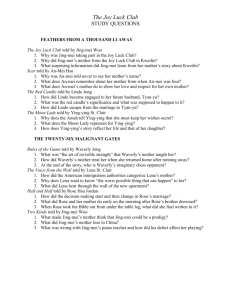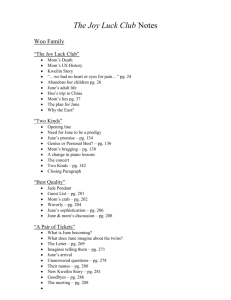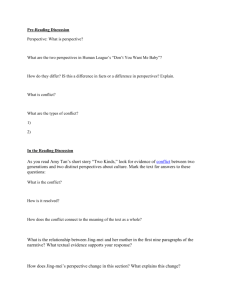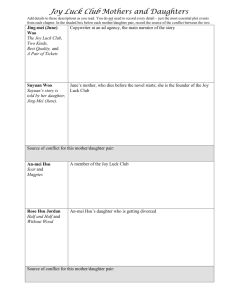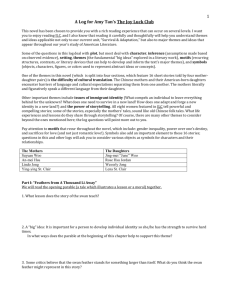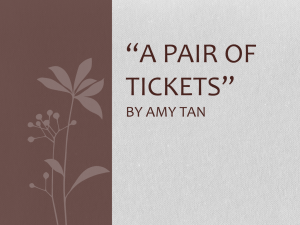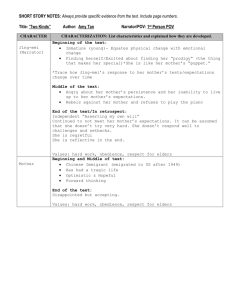JOY LUCK CLUB STUDY GUIDE
advertisement
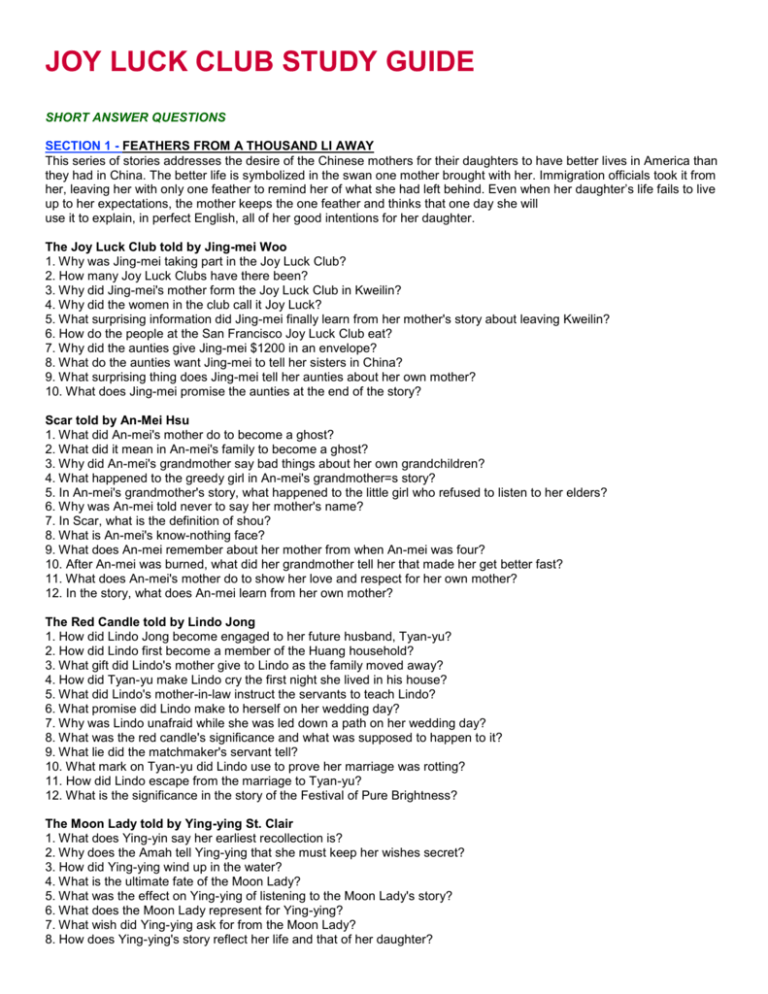
JOY LUCK CLUB STUDY GUIDE SHORT ANSWER QUESTIONS SECTION 1 - FEATHERS FROM A THOUSAND LI AWAY This series of stories addresses the desire of the Chinese mothers for their daughters to have better lives in America than they had in China. The better life is symbolized in the swan one mother brought with her. Immigration officials took it from her, leaving her with only one feather to remind her of what she had left behind. Even when her daughter’s life fails to live up to her expectations, the mother keeps the one feather and thinks that one day she will use it to explain, in perfect English, all of her good intentions for her daughter. The Joy Luck Club told by Jing-mei Woo 1. Why was Jing-mei taking part in the Joy Luck Club? 2. How many Joy Luck Clubs have there been? 3. Why did Jing-mei's mother form the Joy Luck Club in Kweilin? 4. Why did the women in the club call it Joy Luck? 5. What surprising information did Jing-mei finally learn from her mother's story about leaving Kweilin? 6. How do the people at the San Francisco Joy Luck Club eat? 7. Why did the aunties give Jing-mei $1200 in an envelope? 8. What do the aunties want Jing-mei to tell her sisters in China? 9. What surprising thing does Jing-mei tell her aunties about her own mother? 10. What does Jing-mei promise the aunties at the end of the story? Scar told by An-Mei Hsu 1. What did An-mei's mother do to become a ghost? 2. What did it mean in An-mei's family to become a ghost? 3. Why did An-mei's grandmother say bad things about her own grandchildren? 4. What happened to the greedy girl in An-mei's grandmother=s story? 5. In An-mei's grandmother's story, what happened to the little girl who refused to listen to her elders? 6. Why was An-mei told never to say her mother's name? 7. In Scar, what is the definition of shou? 8. What is An-mei's know-nothing face? 9. What does An-mei remember about her mother from when An-mei was four? 10. After An-mei was burned, what did her grandmother tell her that made her get better fast? 11. What does An-mei's mother do to show her love and respect for her own mother? 12. In the story, what does An-mei learn from her own mother? The Red Candle told by Lindo Jong 1. How did Lindo Jong become engaged to her future husband, Tyan-yu? 2. How did Lindo first become a member of the Huang household? 3. What gift did Lindo's mother give to Lindo as the family moved away? 4. How did Tyan-yu make Lindo cry the first night she lived in his house? 5. What did Lindo's mother-in-law instruct the servants to teach Lindo? 6. What promise did Lindo make to herself on her wedding day? 7. Why was Lindo unafraid while she was led down a path on her wedding day? 8. What was the red candle's significance and what was supposed to happen to it? 9. What lie did the matchmaker's servant tell? 10. What mark on Tyan-yu did Lindo use to prove her marriage was rotting? 11. How did Lindo escape from the marriage to Tyan-yu? 12. What is the significance in the story of the Festival of Pure Brightness? The Moon Lady told by Ying-ying St. Clair 1. What does Ying-yin say her earliest recollection is? 2. Why does the Amah tell Ying-ying that she must keep her wishes secret? 3. How did Ying-ying wind up in the water? 4. What is the ultimate fate of the Moon Lady? 5. What was the effect on Ying-ying of listening to the Moon Lady's story? 6. What does the Moon Lady represent for Ying-ying? 7. What wish did Ying-ying ask for from the Moon Lady? 8. How does Ying-ying's story reflect her life and that of her daughter? SECTION 2 - THE TWENTY-SIX MALIGNANT GATES These stories address the mothers telling their daughters how to live. The daughters reject their mothers= ideas, but what the mothers say comes true. This point is symbolized in the mother who tells the daughter not to ride her bicycle around the corner because she will fall down and cry and not be heard by her mother. The daughter rejects the mother's ideas but then she jumps on her bicycle and falls even before she reaches the corner. Rules of the Game told by Waverly Jong 1. What was the art of invisible strength that Waverly's mother taught her? 2. How did Waverly's mother demonstrate the art of invisible strength? 3. How did Waverly learn to play expert chess? 4. What would Waverly's mother say when she attended Waverly's chess exhibition games outdoors? 5. Why did Waverly run away? 6. How did Waverly's mother treat her when she returned home after running away? 7. What was Waverly's mother's view of rules? 8. At the end of the story, who is Waverly's imaginary chess opponent? The Voice from the Wall told by Lena St. Clair 1. What does the dead beggar say when he returns? 2. How did the American immigration authorities categorize Lena's mother? 3. Why does Lena want to know the worst possible thing that can happen to her? 4. Why did Lena start telling lies? 5. What was Lena's great hope when the family moved out of Oakland? 6. What did Lena hear through the wall of the new apartment? 7. Why did the girl from next door leave her own apartment? 8. How did the girl from next door get out of Lena's bedroom? 9. What happened later that night after the girl and her mother had argued? 10. What hope did Lena have after watching the girl next door with her mother? Half and Half told by Rose Hsu Jordan 1. What did Rose's mother used to carry to church services at the First Chinese Baptist Church? 2. What makes Rose sure that her mother knows the Bible is still under a table leg in her kitchen? 3. How did the decision making start and then change in Rose's marriage? 4. What did Rose find out faith was? 5. What was the name of Rose's mother's little Chinese book and what was in it? 6. What did Rose and her mother do early on the morning after Rose's brother drowned? 7. Why did Rose's mother throw her blue sapphire ring into the water? 8. Why did Rose's mother throw an inner tube attached to a fishing pole into the water? 9. When Rose took the Bible out from under the table leg, what did she find written in it? 10. Why was Bing's name written in pencil? Two Kinds told by Jing-mei Woo 1. What made Jing-mei's mother think that Jing-mei could be a prodigy? 2. What did Jing-mei's mother lose in China? 3. How did Jing-mei first envision herself as a prodigy? 4. What would perfection have meant for Jing-mei while she was waiting to become a prodigy? 5. Why did Jing-mei's mother read so many magazines? 6. What happened to all of Jing-mei's mother's early efforts to find out what kind of prodigy Jing-mei should be? 7. What was wrong with Jing-mei's piano teacher and how did his defect affect her playing? 8. What piece did Jing-mei select for the talent show in the church hall? 9. Who was the only person in the church hall who thought Jing-mei's performance was good? 10. What did Jing-mei realize after she had played both Pleading Child and Perfectly Contented a few times? SECTION 3 - AMERICAN TRANSLATION The stories in this section continue the clash between the values of the Chinese mothers and the new lives embraced by the American daughters. This is symbolized in the mirrored armoire in the master suite of the daughter's new condominium. It's mirrors are at the foot of the bed and will reflect happiness away from the daughter. The mother placed a gilt-edged mirror on the headboard of the bed to bring the daughter peachblossom luck, fertility, the grandchildren that the grandmother-to-be desires. Rice Husband told by Lena St. Clair 1. What does the saying, "If the lips are gone, the teeth will be cold", mean? 2. What does Lena's mother see? 3. What are the three things that Lena's mother predicted that came true? 4 What does Lena think her mother will see during her visit with her and Harold? 5. What physical aspect of Lena's house does her mother connect with a feeling? 6. What food does Harold not realize that Lena doesn't eat? 7. Why does Harold hate it when Lena cries? 8. When Lena says, "I knew it would happen", what question does her mother ask? 9. Why does the marble end table collapse? Four Directions told by Waverly Jong 1. What did Waverly want to tell her mother at lunch? 2. What did Waverly's mother do when she found that Waverly had eloped with her first husband? 3. Why did Waverly first stop playing chess as a child? 4. What special thing could Waverly's mother do to change Waverly's view of a person? 5. What mistake did Rich make about the wine at the dinner with Waverly's family? 6. Why was Waverly so anxious that her mother was the queen while she, Waverly, was the pawn? 7. In what way was Waverly confused about where her mother came from? 8. What trip is Waverly contemplating at the end of the story and with whom would she travel? Without Wood told by Rose Hsu Jordan 1. When Rose was little, what did she believe? 2. Why did Rose's mother say that Rose was "without wood"? 3. Why did Rose stay in bed for three days? 4. Where did Rose tell Ted she was going to live? 5. When Rose says that Ted is "hulihudu", what does she mean? 6. What does Rose's mother plan in Rose's garden? Best Quality by Jing-mei Woo 1. What is Jing-mei's life's importance gift from her mother? 2. Why did Jing-mei's mother not want to keep the crab that had lost a leg? 3. Why did Jing-mei leave the room while the crabs were being steamed? 4. How do Jing-mei and her mother disagree in regard to Waverly Jong? 5. How did Waverly insult Jing-mei professionally? 6. Who got the crab with the missing leg? SECTION 4 - QUEEN MOTHER OF THE WESTERN SKIES This series of stories represents the Chinese mothers trying to pass along the message that the daughters should lose their innocence but not their hope. This is symbolized by the woman teasing her baby granddaughter and remembering how she went from freedom and innocence and laughter to learning to protect herself. She taught her daughter to protect herself by shedding her own innocence. Now, seeing the laughing baby, the grandmother wonders if her daughter can learn through the child to keep her hope and to laugh forever. Magpies told by An-mei Hsu 1. In what way does An-mei say that all people born girls are alike? 2. What did it mean to An-mei to be raised "the Chinese way"? 3. How did An-mei's mother dishonor her widowhood? 4. What did the turtle in the pond do to An-mei's tears? 5. What happened to the eggs that poured out of the turtle's beak? 6. What emotion described the magpies? 7. What did the story of the turtles and the magpies teach An-mei's mother to do? 8. How did An-mei learn not to listen to something meaningless calling to her? 9. Why did An-mei's mother send An-mei out of their bedroom at night? 10. Why did An-mei's mother become Wu Tsing's concubine? 11. How did An-mei's mother die? 12. What promise did Wu Tsing make to An-mei's mother after she died? 13. What does An-mei say that her daughter's psychiatrist is? 14. How did the tired Chinese peasants get rid of the birds that were drinking their tears and eating their seeds? Waiting Between the Trees told by Ying-ying St. Clair 1. How has Lena St. Clair unknowingly insulted her mother by giving her the guest bedroom in her home? 2. What did Lena do when she was born? 3. When Ying-ying was a young girl in Wushi, she was "lihai". What does that mean? 4. When did Ying-ying begin to know things before they happened? 5. What sign happened to convince Ying-ying that she would marry the man who was a guest at her house? 6. Why did Ying-ying's husband leave her? 7. What is the difference between what Lena sees in her mother and what her mother really is? 8. Why, according to Ying-ying, is the tiger gold and black? 9. Why does Ying-ying abort her first child? 10. What did Ying-ying do for ten years at the country home of her cousin's family? 11. What did Ying-ying give up when she married St. Clair? 12. At the end of the story, what does Ying-ying want to do for her daughter? Double Face told by Lindo Jong 1. Why does Waverly Jong want to go to China? 2. Why does Waverly especially want to be Chinese? 3. Why could Lindo's children not have American circumstances and Chinese character? 4. Who first taught Lindo about America? 5. What kind of job did Lindo get in the cookie factory? 6. What was the fortune inside the cookie that Lindo gave to Tin? 7. Why does Waverly like the fact that she and her mother have crooked noses? 8. At the end of the story, what is Lindo wondering about? A Pair of Tickets told by Jing-mei Woo 1. Why does Jing-mei feel different as her train leaves the Hong Kong border and enters Shenzhen, China? 2. Where is Jing-mei meeting her two half-sisters? 3. How did the half-sisters learn that their mother was dead? 4. How did Jing-mei learn the details of what happened to her half-sisters? 5. Why did Jing-mei's mother actually leave the babies? 6. Who found the babies? 7. What are the two different Chinese meanings of Suyuan, Jing-mei's mother's name? 8. What are the meanings of Jing-mei's name? JOURNAL ESSAY QUESTIONS Choose 25 - Minimum of 1 complete paragraph (5 complex sentences) each in your journals 1. How is point of view used in the book, and what effect does using it this way have? 2. Discuss the use of setting in the book. 3. Are the characters in The Joy Luck Club stereotypes? If so, explain the usefulness of employing stereotypes in the book. If they are not, explain how they merit individuality. 4. What are the main conflicts in the story? Are they resolved? If so, how? If not, why not? 5. Amy Tan uses the words "and" and "but" often to start sentences. What is the effect of this stylistic device? 6. Compare and contrast the four daughters. 7. Compare and contrast the four mothers. 8. Compare and contrast any of the minor characters that you find particularly interesting, including the fathers. 9. Compare and contrast the relationships of the daughters with the mothers. 10. Explain the significance of the title The Joy Luck Club. 11. Explain the significance of the titles of the stories of the book and why the stories that are included in each section fit there. 12. Explain the significance of each of the titles of the stories. 13. Discuss the structure of the book. In what order are the stories told? Why do you think they are told that way? 14. Make a list of the most important secondary characters in the book and explain how each is important. 15. Describe Amy Tan's writing style. How does it influence our perception of the story? 16. Who is the main character of the book? Defend your choice. 17. What themes are present in The Joy Luck Club? Explain each. 18. What is one of the main points of the book The Joy Luck Club? Explain with details from the text. 19. How is point of view used in the book, and what effect does using it this way have? 20. Discuss the use of setting in the book. 21. Are the characters in The Joy Luck Club stereotypes? If so, explain the usefulness of employing stereotypes in the book. If they are not, explain how they merit individuality. 22. What are the main conflicts in the story? Are they resolved? If so, how? If not, why not? 23. Amy Tan uses the words “and” and “but” often to start sentences. What is the effect of this stylistic device? 24. Compare and contrast the four daughters. 25. Compare and contrast the four mothers. 26. Compare and contrast any of the minor characters that you find particularly interesting, including the fathers. 27. Compare and contrast the relationships of the daughters with the mothers. 29. Explain the significance of the title The Joy Luck Club. 30. Explain the significance of the titles of the stories of the book and why the stories that are included in each section fit there. 31. Explain the significance of each of the titles of the stories. 32. Discuss the structure of the book. In what order are the stories told? Why do you think they are told that way? 33. Make a list of the most important secondary characters in the book and explain how each is important. 34. Describe Amy Tan's writing style. How does it influence our perception of the story? 35. Who is the main character of the book? Defend your choice. 36. What themes are present in The Joy Luck Club? Explain each. 37. What is one of the main points of the book The Joy Luck Club? Explain with details from the text. 38. The book is set up so that you sometimes read about one person from another person’s point of view. Then you read about the person from their own point of view. For example, in Rules of the Game, you read about Lindo Jong from her daughter’s viewpoint. Later, though, in Double Face, you get to see Lindo’s point of view about herself and about her daughter. Some shifts in point of view are bound to change our minds sometimes when we read a second, or perhaps a third, story. Demonstrate one example of how this happened to you as you progressed through The Joy Luck Club. 39. The original name of The Joy Luck Club was Wind and Water. Which title do you think is best? Why? 40. Which of the mothers and which of the daughters do you think is most interesting? Why? 41. According to Amy Tan’s stories, what kind of relationship do most mothers and daughters have? 42. If you had to choose one of the mothers to be your mother, which one would you choose? Why? 43. If you were a parent to one of the daughters, which one would you want to be your child? Why? 44. Which story was your personal favorite? Why? 45. Choose one story you think could be expanded into a full-length novel. Give some examples of how it could be expanded. 46. Do you think the mothers and daughters in the stories are typical of mothers and daughters in general? Why? 47. Of all the minor characters (not mothers or daughters) in The Joy Luck Club, which is your favorite and why? 48. Of all the mothers in The Joy Luck Club, which is your favorite and why? 49. Of all the daughters in The Joy Luck Club, which is your favorite and why? 50. Of all the men in The Joy Luck Club, which is your favorite and why? CULMINATING PROJECT Lindo's In-Laws lived in a large house on a hill. Think about the stories of the house and who lived in them. Think about the construction of the house and the strength of each story in Comparison to who lived on that level. Also, think about the environment around the house and the purpose of that environment. In your life you place importance on certain things and rank things based on their importance to your stability. What one thing is your foundation? What is not your foundation but is the next most important thing in your life? Make a list of the 5 things that you consider to be most important in your life and the environment that you feel surrounds your current life: season, landscape, weather, foliage, etc. Express your life in the form of a house and it’s environment. You will build your house with a foundation that is strong and relates to the foundation from your list. The first story will be a related building material that is not quiet as strong but strong enough to hold the floors above it and that story will express the second most important thing in your life. Continue to the roof, using the description and meaning of the stories in Lindo’s In-Law’s home as your guide to relate to your life. Then, place your house inside an environment that you feel expresses your environment. Detail is very important in this project. You MUST be able to EXPLAIN the building products you used, the environment, the floors, why they are where they are, and why the are made of the materials of which they are made. There is no size restriction, but houses most be at least 6 inches square to properly express the building material and strength. The total size, including your environment, must be at least 12 inches square. In addition to the house, you will construct a speech in which you will explain your house and environment. You must explain each floor, roof, and environment and why they are important to you and why they are placed in the positions in which you have placed them. You must explain your symbolism and choices.
